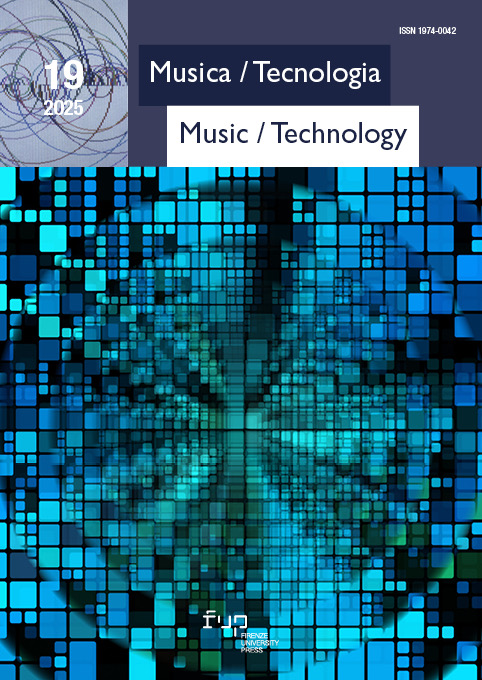Published 2025-06-10
Keywords
- feedback system,
- live electroacoustic music,
- performative gesture
How to Cite
Copyright (c) 2025 Giovanni Verga

This work is licensed under a Creative Commons Attribution-NonCommercial 4.0 International License.
Abstract
This paper delves into the compositional process and performance of the work Totem, a piece I composed in 2019 triggered by the desire to explore and manage the unpredictability of feedback system. The paper outlines the development of the created system that leverages physical feedback, by incorporating acoustic instruments and exploring their resonant properties. An analysis of instruments preparation, system components, and the performative gestures highlights the symbiotic relationship between the musician and the feedback mechanism. The dramaturgical aspect emphasizes the ritualistic interactions of the performer with the feedback system, symbolizing a journey towards self-acceptance and challenging societal norms. The paper also discusses the technical setup, including the system in Reaper and Max, score, spatialization technique, and the collaborative dynamics between the performers. Insights from the performer’s experience further contextualize the performative and sonic exploration within Totem, offering a comprehensive overview of the piece’s approach to live electronic music performance.
Downloads
References
- Di Scipio, A. (2003). Sound is the Interface: From Interactive to Ecosystemic Signal Processing. Organised Sound, 8(3), 269-277. https://doi.org/10.1017/S1355771803000244. DOI: https://doi.org/10.1017/S1355771803000244
- Emmerson, S. (2007). Living Electronic Music. Ashgate Publishing. https://doi.org/10.4324/9781351217866. DOI: https://doi.org/10.4324/9781351217866
- Heiniger, Wolfgang. “Mehr! Kleines Handbuch des Lautsprecherorchesters.” Draft version, Unpublished, April 9, 2015.
- Moore, F. R. (1988). The Dysfunctions of MIDI. Computer Music Journal, 12(1), 19-28. https://doi.org/10.2307/3679834. DOI: https://doi.org/10.2307/3679834
- Saladin, Matthieu (2017). Electroacoustic Feedback and the Emergence of Sound Installation: Remarks on a Line of Flight in the Live Electronic Music by Alvin Lucier and Max Neuhaus. Organised Sound, 22(2), 268-275. https://doi.org/10.1017/S1355771817000176. DOI: https://doi.org/10.1017/S1355771817000176
- Smalley, D. (1997). Spectromorphology: Explaining Sound-Shapes. Organised Sound, 2, 107-126. https://doi.org/10.1017/S1355771897009059. DOI: https://doi.org/10.1017/S1355771897009059
- Smalley, D. (2007). Space-Form and the Acousmatic Image. Organised Sound, 12, 35-58. https://doi.org/10.1017/S1355771807001665. DOI: https://doi.org/10.1017/S1355771807001665
- Teruggi, D. (2007). Technology and Musique Concrète: The Technical Developments of the Groupe de Recherches Musicales and Their Implication in Musical Composition. Organised Sound, 12(3), 213-231. https://doi.org/10.1017/S1355771807001665. DOI: https://doi.org/10.1017/S1355771807001914
- Van Eck, C. (2017). Between Air and Electricity: Microphones and Loudspeakers as Musical Instruments. Chapter 4: “Movement, Material, and Space: Interacting with Microphones and Loudspeakers.” Bloomsbury, (pp. 83-138). https://doi.org/10.5040/9781501327636. DOI: https://doi.org/10.5040/9781501327636.ch-005
- Weibel, P., ed. (2019). Sound Art: Sound As a Medium of Art. Karlsruhe, Germany: ZKM/Center for Art and Media.
- Williamon, A. (2004). “Feedback learning of musical expressivity”, in A. Williamon (ed.), Musical Excellence: Strategies and Techniques to Enhance Performance. Oxford: Oxford Academic, (pp. 247-270). https://doi.org/10.1093/acprof:oso/9780198525356.003.0013. DOI: https://doi.org/10.1093/acprof:oso/9780198525356.003.0013
- Wishart, T. (1986). On Sonic Art. Harwood Academic Publishers, (pp. 146-147).

